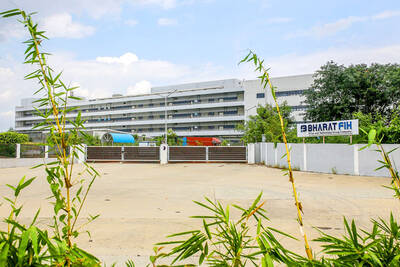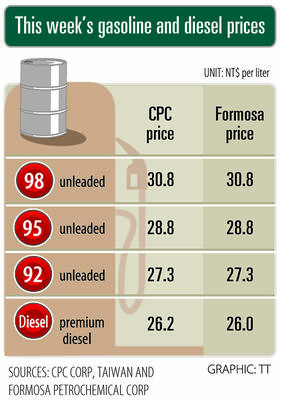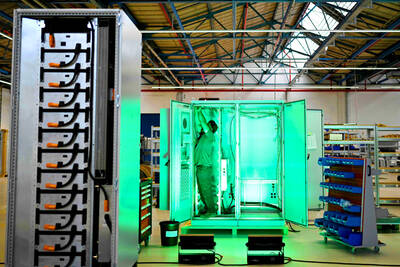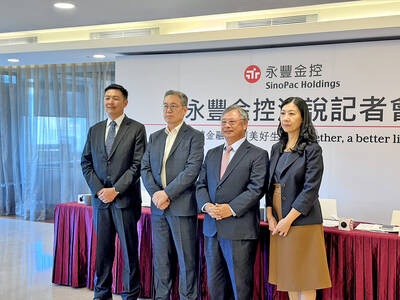From Yantian (鹽田) to Hamburg, world trade is in the doldrums and Christian Blauert, who heads the largest container terminal in Germany’s northern port of Hamburg, need only check the Web cams to knows things aren’t getting better.
On his computer he has access to a live-feed of pictures from Chinese harbors like Yantian showing mountains of empty containers, waiting for exports to pick up.
“The situation in the international port of Yantian is typical,” referring to the site near Hong Kong. “You can hardly see the full containers because the terminals are crowded with empties.”
The pictures illustrate that when the container ships come steaming into Hamburg from China, in six to seven weeks’ time after going round Africa to save paying Suez Canal transit fees, they will be carrying far fewer TV sets, bicycles, T-shirts and toothbrushes than at the same time last year.
At the HHLA (Hamburger Hafen und Logistik Aktiengesellschaft) Burchardkai terminal, where giant cranes on rails dominate the skyline, Blauert declines to say when business might pick up.
“It’s like navigating in the fog, you can only see what’s just ahead,” he says.
His firm expects turnover to be down by more than 10 percent this year because of the economic downturn and a number of HHLA’s 3,700 Hamburg employees will be facing short-time work as of this summer.
Axel Gedashko, economy minister in the city-state about 100km down river from the North Sea, does not mince his words: “The situation is dramatic,” he says.
“Trade in volume in the port of Hamburg is down by a quarter compared to last year” when nearly 10 million TEU (twenty foot equivalent unit), the figure used for calculating the number of containers shipped, went through the harbor, Gedashko says.
Shipping these days in Hamburg — Germany’s largest port and Europe’s second-largest after Rotterdam — is all about containers because 97 percent of goods are moved that way.
China was Hamburg’s most important trading partner last year, accounting for 32 percent in volume of the 140 million tonnes shipped through the port. Singapore came second, followed by Russia.
The world crisis “is hitting us badly because the port is at the center of logistics for northern Germany,” Gedashko says.
“And the situation here reflects the state of the world economy, not just in Hamburg and Germany, but for the whole of eastern Europe” because Hamburg, especially since the fall of the Iron Curtain, serves as the gateway for much of central and northern Europe, he says.
In this city-state of 1.8 million people, unemployment is up to 78,000, including 10,000 in the logistics sector, with at least 30,000 more on short-time, Gedashko says.
The city is worried. A poll by the Haspa bank showed 30 percent of firms connected with the harbor expect a bad year, 60 percent stagnation and just 6 percent think business will be good.

SETBACK: Apple’s India iPhone push has been disrupted after Foxconn recalled hundreds of Chinese engineers, amid Beijing’s attempts to curb tech transfers Apple Inc assembly partner Hon Hai Precision Industry Co (鴻海精密), also known internationally as Foxconn Technology Group (富士康科技集團), has recalled about 300 Chinese engineers from a factory in India, the latest setback for the iPhone maker’s push to rapidly expand in the country. The extraction of Chinese workers from the factory of Yuzhan Technology (India) Private Ltd, a Hon Hai component unit, in southern Tamil Nadu state, is the second such move in a few months. The company has started flying in Taiwanese engineers to replace staff leaving, people familiar with the matter said, asking not to be named, as the

The prices of gasoline and diesel at domestic fuel stations are to rise NT$0.1 and NT$0.4 per liter this week respectively, after international crude oil prices rose last week, CPC Corp, Taiwan (台灣中油) and Formosa Petrochemical Corp (台塑石化) announced yesterday. Effective today, gasoline prices at CPC and Formosa stations are to rise to NT$27.3, NT$28.8 and NT$30.8 per liter for 92, 95 and 98-octane unleaded gasoline respectively, the companies said in separate statements. The price of premium diesel is to rise to NT$26.2 per liter at CPC stations and NT$26 at Formosa pumps, they said. The announcements came after international crude oil prices

A German company is putting used electric vehicle batteries to new use by stacking them into fridge-size units that homes and businesses can use to store their excess solar and wind energy. This week, the company Voltfang — which means “catching volts” — opened its first industrial site in Aachen, Germany, near the Belgian and Dutch borders. With about 100 staff, Voltfang says it is the biggest facility of its kind in Europe in the budding sector of refurbishing lithium-ion batteries. Its CEO David Oudsandji hopes it would help Europe’s biggest economy ween itself off fossil fuels and increasingly rely on climate-friendly renewables. While

SinoPac Financial Holdings Co (永豐金控) is weighing whether to add a life insurance business to its portfolio, but would tread cautiously after completing three acquisitions in quick succession, president Stanley Chu (朱士廷) said yesterday. “We are carefully considering whether life insurance should play a role in SinoPac’s business map,” Chu told reporters ahead of an earnings conference. “Our priority is to ensure the success of the deals we have already made, even though we are tracking some possible targets.” Local media have reported that Mercuries Life Insurance Co (三商美邦人壽), which is seeking buyers amid financial strains, has invited three financial